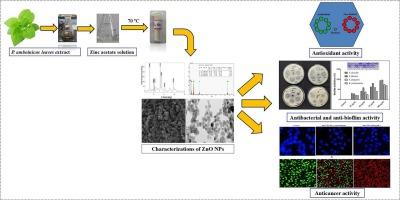黄酮类化合物和富含蛋白质的牛蒡叶提取物包被氧化锌纳米颗粒的绿色合成方法
IF 4.7
2区 医学
Q1 BIOCHEMISTRY & MOLECULAR BIOLOGY
引用次数: 0
摘要
本研究展示了利用富含黄酮类化合物和蛋白质的植物提取物制备氧化锌纳米颗粒(ZnO NPs)的生态友好型工艺。紫外可见光谱显示,叶提取物和合成的ZnO NPs分别在288 nm和358nm处有明显的吸光度峰。x射线衍射(JCPDF文件编号:00-036-1451)验证了纳米颗粒中六方纤锌矿晶体相的存在。FTIR分析表明,黄酮类化合物和蛋白质作为生物还原剂,促进电子向Zn2+离子转移,从而将其转化为零价(Zn0)状态,从而形成ZnO NPs。扫描电镜(SEM)和透射电镜(TEM)分析显示ZnO纳米粒子为球形,平均尺寸为58.24 nm。这些纳米颗粒表现出强大的抗菌作用,成功抑制了福氏志贺氏菌和粪肠球菌,当浓度为100 μg/mL时,生物膜抑制率超过93%。在200 μg/mL浓度下,总抗氧化能力为75.5±0.24 μg AAE/mg,还原能力为65.24±0.73 μg AAE/mg,清除DPPH自由基的能力为68.30±0.16%。细胞毒性评价显示,200 μg/mL时活性最强。24 h、48 h、72 h的IC50分别为58.53、40、21.69 μg/mL,荧光染色结果显示细胞凋亡有明显变化。这些发现突出了P. amboinicus包被氧化锌纳米颗粒作为功能性食品和治疗的可行候选物的多方面潜力,可用于解决抗菌素耐药性、氧化应激和癌症。本文章由计算机程序翻译,如有差异,请以英文原文为准。

Green synthesis approach for flavonoids and protein-rich Plectranthus amboinicus leaf extract-coated ZnO nanoparticles for diverse biological applications
This study demonstrates the eco-friendly fabrication of zinc oxide nanoparticles (ZnO NPs) using a flavonoid- and protein-rich extract from Plectranthus amboinicus, a medicinal herb renowned for its therapeutic properties. UV–vis spectroscopy showed distinct absorbance peaks at 288 nm for the leaf extract and 358 nm for the synthesized ZnO NPs. X-ray diffraction (JCPDF file no. 00–036-1451) verified the presence of the hexagonal wurtzite crystalline phase in the nanoparticles. FTIR analysis revealed that flavonoids and proteins act as bio-reductants and facilitate the electron transfer to the Zn2+ ions, thereby converting them to their zero-valent (Zn0) state, leading to the formation of ZnO NPs. Scanning electron microscope (SEM) and transmission electron microscope (TEM) analyses revealed spherical ZnO NPs with an average size of 58.24 nm. These nanoparticles exhibited potent antimicrobial effects, successfully inhibiting Shigella flexneri and Enterococcus faecalis, with biofilm inhibition rates surpassing 93 % at a concentration of 100 μg/mL. Antioxidant evaluations indicated a total antioxidant capacity of 75.5 ± 0.24 μg AAE/mg, a reducing power of 65.24 ± 0.73 μg AAE/mg, and 68.30 ± 0.16 % DPPH radicals scavenging activity at 200 μg/mL. Cytotoxic assessments showed the most significant activity at 200 μg/mL. The IC50 values were recorded as 58.53 μg/mL, 40 μg/mL, and 21.69 μg/mL for treatments at 24 h, 48 h, and 72 h. Additionally, the fluorescence staining assay confirms significant apoptotic changes. The findings highlight the multifaceted potential of P. amboinicus-coated ZnO nanoparticles as viable candidates for functional foods and therapies, addressing antimicrobial resistance, oxidative stress, and cancer.
求助全文
通过发布文献求助,成功后即可免费获取论文全文。
去求助
来源期刊

Bioorganic Chemistry
生物-生化与分子生物学
CiteScore
9.70
自引率
3.90%
发文量
679
审稿时长
31 days
期刊介绍:
Bioorganic Chemistry publishes research that addresses biological questions at the molecular level, using organic chemistry and principles of physical organic chemistry. The scope of the journal covers a range of topics at the organic chemistry-biology interface, including: enzyme catalysis, biotransformation and enzyme inhibition; nucleic acids chemistry; medicinal chemistry; natural product chemistry, natural product synthesis and natural product biosynthesis; antimicrobial agents; lipid and peptide chemistry; biophysical chemistry; biological probes; bio-orthogonal chemistry and biomimetic chemistry.
For manuscripts dealing with synthetic bioactive compounds, the Journal requires that the molecular target of the compounds described must be known, and must be demonstrated experimentally in the manuscript. For studies involving natural products, if the molecular target is unknown, some data beyond simple cell-based toxicity studies to provide insight into the mechanism of action is required. Studies supported by molecular docking are welcome, but must be supported by experimental data. The Journal does not consider manuscripts that are purely theoretical or computational in nature.
The Journal publishes regular articles, short communications and reviews. Reviews are normally invited by Editors or Editorial Board members. Authors of unsolicited reviews should first contact an Editor or Editorial Board member to determine whether the proposed article is within the scope of the Journal.
 求助内容:
求助内容: 应助结果提醒方式:
应助结果提醒方式:


